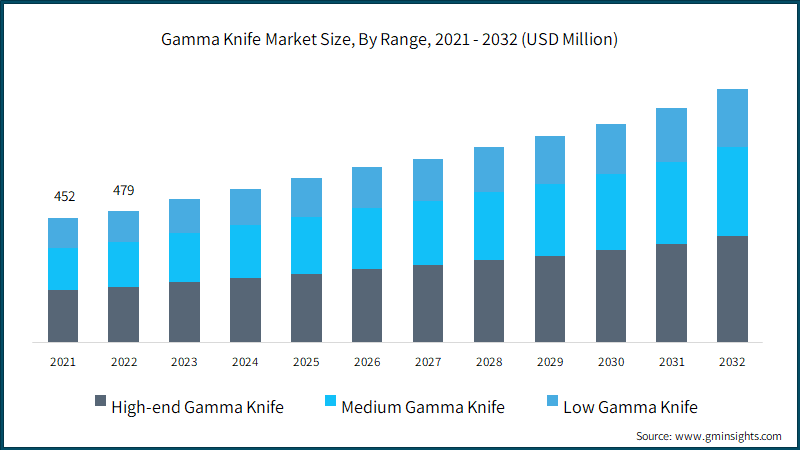Home > Healthcare > Medical Devices > Surgical Devices > Gamma Knife Market
Gamma Knife Market Analysis
- Report ID: GMI6123
- Published Date: Jun 2023
- Report Format: PDF
Gamma Knife Market Analysis
Based on range, the gamma knife market is segmented as high-end gamma knife, medium gamma knife, and low gamma knife. The high-end gamma knife segment was valued at over USD 201 million in 2022. This segmental share is attributable to the several benefits associated with the high-end gamma knife devices in treating various conditions in the brain. This device uses highly focused radiation beams to target specific areas in the brain with exceptional precision. This accuracy helps minimizing exposure to surrounding healthy tissues, reducing the risk of damage to critical structures, and lessening side effects. According to the research studies, gamma Knife has shown excellent long-term effectiveness in treating certain conditions, particularly brain tumors and arteriovenous malformations (AVMs).
It offers a high rate of tumor control and AVM obliteration, leading to improved outcomes and increased survival rates for patients. Similarly, patients experience minimal discomfort and have a relatively quick recovery time compared to traditional surgery. As a result, several benefits related to high-end gamma knife are expected to augment the business revenue.

Based on indication, the gamma knife market is segmented as head & neck cancer, arteriovenous malformations, brain metastases, malignant tumors, trigeminal neuralgia, and others. The brain metastases segment was valued at around USD 154 million in 2022. The segment has recorded the significant share in recent years due to advancements in technology, increased awareness related to early-stage disease diagnosis, etc. Gamma knife is allowing the precise delivery of a high dose of radiation to the tumor while minimizing exposure to nearby critical structures. This high-dose treatment can effectively control the growth of brain metastases and reduce the risk of recurrence.
In many cases, gamma knife radiosurgery can be completed in a single treatment session. This ability to complete treatment in a shorter time frame compared to traditional radiation therapy is advantageous for patients, as it minimizes the inconvenience and potential side effects associated with multiple treatment sessions. Moreover, gamma knife radiosurgery is a reliable treatment option for patients with brain metastases that are inoperable due to factors such as tumor size, location, or the presence of multiple tumors. It provides a non-invasive alternative for those that are not suitable candidates for surgical resection.
Based on end-use, the gamma knife market is segmented as hospitals, specialty clinics, radiotherapy centers, and others. The hospitals segment is projected to reach more than USD 421 million by the end of 2032. Hospitals play a crucial role in the treatment of neurological disorders and offer several advantages for patients. Hospitals commonly have multidisciplinary teams consisting of various healthcare professionals including oncologists, radiologists, pathologists, and nurses among others. This collaborative approach ensures that patients receive comprehensive and integrated care from experts in different specialties, leading to improved outcomes.
Hospitals often have access to advanced medical technologies, equipment, and infrastructure required for the diagnosis and treatment of cancer & neurological ailments. This includes cutting-edge imaging techniques, radiotherapy machines, and specialized laboratories, enabling accurate diagnosis and personalized treatment options. Similarly, hospitals offer a range of supportive care services to enhance the overall well-being of patients. These services may include psychological counselling, pain management, nutritional guidance, rehabilitation, and support groups.

U.S. gamma knife market is anticipated to expand at a considerable pace to reach around USD 298 million by 2032. This dominant share is attributable to the various factors such as advanced healthcare infrastructure, high healthcare spending, and a strong emphasis on technological advancements in medical devices among others. The country has witnessed the adoption of gamma knife technology in various leading medical centers and hospitals. Technological advancements in gamma knife systems, such as integrated imaging and treatment planning software have also contributed to market expansion.
Brain tumor is a significant health concern in the U.S., and the demand for effective treatment options has driven the growth of the market in the country. Access to adequate reimbursement for target disease treatment procedures encourages the adoption of advanced medical devices. Moreover, ongoing R&D activities focused on improving treatment outcomes and reducing side effects have led to the introduction of new and more advanced gamma knife equipments.

